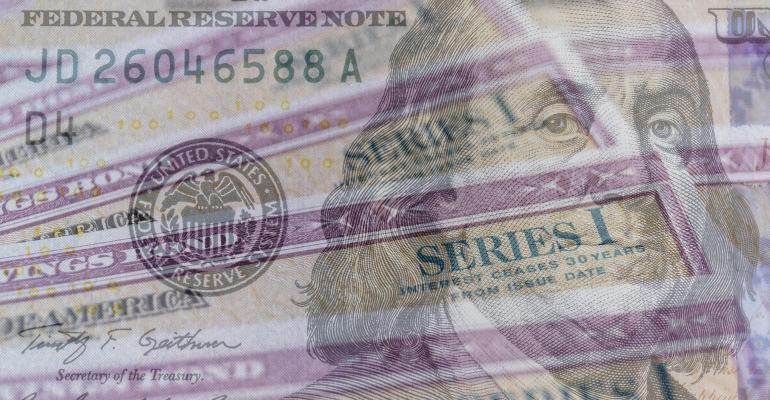(Bloomberg) -- Just six months ago, investors were plowing billions of dollars into I bonds. Now, some experts say it’s time to get out.
The yield on series I savings bonds is expected to fall to around 3.8% in May, down from the current 6.89% and a historic 9.62% rate last year. The bonds’ yield is tied to inflation, which is showing signs of cooling.
These days, investing options including high-yield savings accounts, money market funds and certificates of deposits are offering competitive rates, making I bonds look less attractive in comparison.
Read more: I Bonds Lose Their Luster With Yield Set to Plunge Below 4%
So what do you do if you’re currently holding I bonds? For those who purchased them less than a year ago, there’s not much to do but wait, since the bonds must be held for at least that long. For others, the decision is a bit more complicated — alternative options might offer better rates for your money, but cashing out I bonds before five years means losing interest from the prior three months.
We asked some financial experts for their advice. Here’s what they told us.
The Case For Cashing Out
Giving up three months of interest is never fun, but it could be the best option for long-term returns.
Angela Dorsey, founder of Dorsey Wealth Management in California, recommends investors seriously consider other options for their money and compare the rates. For instance, many certificates of deposit — which often have a lockup period, usually a year or two — are boasting rates above 4%. Goldman Sachs Group’s Marcus is even offering a promotional 10-month CD with a 5.05% annual percentage yield.
High-yield savings accounts also have comparable yields, said Dana Menard, founder of Twin Cities Wealth Strategies in Minnesota. These products are more liquid than I bonds — investors can pull their money out at any time without losing interest.
Marcus’s high-yield account currently has a 3.9% rate, while those from Barclays and Ally Bank offer 3.8% and 3.75% respectively.
“The I bond frenzy is coming to an end as inflation moderates,” said Noah Damsky, principal at Marina Wealth Advisors. He recommends looking at Treasury bills, which can be bought on the TreasuryDirect website or through ETFs like the iShares 0-3 Month Treasury Bond ETF (SGOV). A one-month T-bill currently has a rate of about 3.8% and a three-month one yields around 5%.
Timing Strategy
If you do decide to unload your I bonds after less than five years, be strategic about which three months of interest you’re going to give up.
“Even once they announce the official new rate, it won’t be effective for you until you’ve had six months of the current 6.89% rate, so you’ll likely want to make sure you’ve gotten your full six months of that rate,” said Brittany Brinckerhoff, financial adviser at Hilltop Wealth Advisors in North Carolina.
Say that you purchased I bonds on April 10. You’ll still receive the 6.89% interest rate for the subsequent six months, meaning until Oct. 10. Then, the rate will be an estimated 3.8%. If you wait three more months — until Jan. 10, 2024 — you’ll be giving up three months of the 3.8% interest instead of the 6.89% interest.
That timeline will be different for everyone depending on their date of purchase, but try to think strategically about how to maximize your interest, said Gordon Achtermann, financial planner at Your Best Path Financial Planning in Virginia.
The Case For Hanging On
Despite the falling rate, I bonds can still provide a stable return if you’re willing to be patient.
“If an investor’s primary goal is protection from future rises in inflation, it’s likely still worth sticking to the original I bond plan,” said Craig Toberman, founder of Toberman Wealth in St. Louis. If inflation starts to heat up again, rates will improve in the future.
I bond investors have already dealt with the onerous TreasuryDirect website and set up accounts, he added. Withdrawing money and moving it to a new place will just take more work and frustration.
Kyle Newell, owner of Newell Wealth Management, notes that a 3.8% rate is still a solid investment and much better than keeping your funds in a traditional bank account, which pays next to nothing.
Those considering taking their cash out of I bonds should think about what they want to achieve with the funds, Brinckerhoff said. Is it worth your time and effort to move your money around, and to lose three months of interest? Do you know where you want to put the cash instead, and will that fit your overall investment goals?
And regardless of your view on I bonds, it’s worth holding on until May 1 to learn the new official rate, said Jeremy Keil, financial advisor at Keil Financial Partners. It’s determined by inflation data as well as a somewhat enigmatic fixed rate that’s set by the Treasury Department and lasts for the life of the bond. That second part won’t be known until May 1.
“If it’s the new rate you don’t like, wait until that’s the rate you’re giving up,” he said. “Take the time to figure out when your I bond renews.”
--With assistance from Charlie Wells.
To contact the author of this story:
Claire Ballentine in New York at [email protected]





